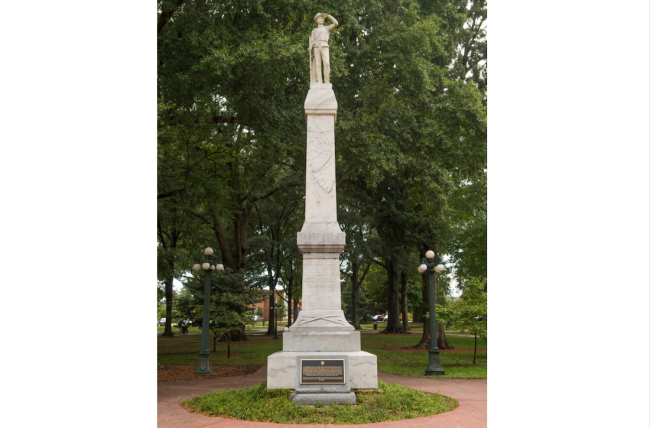You have /5 articles left.
Sign up for a free account or log in.

The State Institutions of Higher Learning Board of Trustees in Mississippi voted on June 18 to relocate a monument dedicated to Confederate soldiers to a cemetery on the University of Mississippi campus.
University of Mississippi
Black college students, faculty members and visitors have long been expected to simply “shrug their shoulders” when they pass by statues on campus honoring Confederate figures and proponents of white supremacy, or buildings or monuments named for them, said Erika Wilson, a professor of law and chair of public policy at the University of North Carolina School of Law.
She was relieved, as a Black faculty member, when Silent Sam, the statute of a Confederate soldier on the Chapel Hill campus, was removed nearly two years ago. But there are still physical and written reminders at Chapel Hill and many colleges across the country that send an opposite message of the “welcoming” and “inclusive” environment college leaders say they want to provide for people of color, said Wilson, who is also an expert in critical race theory.
“It’s tragic that people didn’t think critically about what it would be like to attend a university with a monument named after someone who was genocidal and created great harm against people that look like you,” she said.
But the highly publicized and unjust killings of Black people this year, and the widespread protests across the country over the May killing of George Floyd, has prompted new introspection among many college leaders, who are quickly taking steps to remove the names of such controversial figures from buildings and to move the monuments off campuses -- never mind that repeated calls by students and faculty members for these very actions were ignored for many years. There is a new urgency from college presidents and boards of trustees to examine how campus policies and structures can perpetuate racism and white supremacy, said Lynn Pasquerella, president of the Association of American Colleges and Universities.
“You have students coming in and demanding that the messages being espoused are reflected in the reality of campus life,” Pasquerella said. “Students are saying rightly … ‘This is my home, it’s not just a place of learning.’”
Over the last month, a flurry of colleges has worked to align their recent statements against racial injustice with action by removing reminders of white supremacy on campus. Western Carolina University renamed its auditorium, which was named for Clyde Hoey, a former North Carolina governor who opposed racial integration in the early 1900s. The change was “long overdue,” Chancellor Kelli Brown said in a statement. Queens University in Charlotte, N.C., renamed its administration building, which was previously named for the Reverend Robert Armistead Burwell, who had “direct ties to slavery.” University staff members had raised alarms about the Burwell name in late 2019, a press release from the university said. Indiana University recently formed a committee to review the name of Jordan Hall, which houses the biology department on its Bloomington campus. The building is named for David Starr Jordan, a former zoology professor and university president during the late 1800s, a statement from the university said. A student-led petition is circulating to remove Jordan’s name due to his support for eugenics.
Clemson University in South Carolina renamed its honors college, which was previously named for John C. Calhoun. President Jim Clements said the university’s Board of Trustees moved up a previously scheduled vote on the renaming because they felt it was the “right time” to make the change. Princeton University took Woodrow Wilson’s name off its School of Public and International Affairs and one of its residential colleges, citing the former American president’s “segregationist policies.” Princeton's Board of Trustees had previously decided in 2016 to keep Wilson's name on the buildings.
“The board reconsidered these conclusions this month as the tragic killings of George Floyd, Breonna Taylor, Ahmaud Arbery, and Rayshard Brooks drew renewed attention to the long and damaging history of racism in America,” President Christopher Eisgruber said in a message to students and staff members. “Princeton is part of an America that has too often disregarded, ignored, or excused racism, allowing the persistence of systems that discriminate against Black people.”
Last month, the Board of Trustees at Chapel Hill lifted a 16-year ban on renaming campus buildings and changing monuments. Fierce debate about the removal of Silent Sam had previously divided the campus and state residents until the monument was turned over to a Confederate memorial group in December.
Wilson said faculty members had been pushing for the moratorium to be lifted since it was implemented in 2015 and renewed that effort with a petition in February. The decision by the trustees is an example of how “this moment inspired” them to act in a way they did not when addressing the controversy over Silent Sam, she said.
Chapel Hill chancellor Kevin Guskiewicz and Richard Stevens, chair of the Board of Trustees, acknowledged in a statement that the campus has “struggled for decades” with its association with white supremacists, slave owners and racists. As the country is confronting this history, so too is the university, Guskiewicz and Stevens said.
“We are living in a world where change should be fueled by a desire to create and embrace a more inclusive world, not resisted by fear,” the statement said. “Today, we are sending a clear message to the Carolina Community that we will reconcile our past and create a future that reflects the inclusivity and equality that our nation and the world deserve and demand.”
The national unrest over racial injustice in government and social systems and the widespread demands from students and faculty members for colleges to act has caused administrators to bypass old debates that occurred when disputes arose over building names or monuments, Pasquerella said. Leaders had the “luxury” of considering the perspective of people who favored retaining symbols of American and institutional history on campus and debating the value of commemorating the country’s painful past, she said.
Henry Stoever, president and chief executive officer of the Association of Governing Boards, said boards of trustees and governors make decisions by prioritizing certain issues over others depending on the current “environmental situation.” He said he doesn’t believe boards necessarily blocked such changes from occurring in the past, but they may not have prioritized them as much as they do today.
“When a board develops an agenda for an upcoming meeting, you can’t talk about everything,” Stoever said. “You have to prioritize these topics. The environment is likely causing some boards to reprioritize topics.”
Wilson believes the critical race theory concept of “interest convergence” is at play in college leaders’ decision making. They are realizing that their reputations, and those of their institutions, can benefit by making changes that Black people have long requested -- or suffer if they do not. Refusing to remove the names of white supremacists in this moment of great social pressure to do so can influence the recruitment, enrollment and retention of Black students and athletes and affect institutions' bottom line, she said.
“It’s bad business to not recognize or have overt signs of white supremacy out in the open,” Wilson said. “There are students of color who have said, ‘We don’t want to go to a university that has this history,’ and are distancing themselves from it.”
Wilson said she hopes the college leaders' newfound recognition of the need for change isn’t fleeting, and that the activists demanding change do not get complacent.
“While we have the attention, it’s important to push on these issues,” she said. “If we’re really going to enter a new phase on college campuses where all students are welcome, it’s time to reconsider the physical space.”








